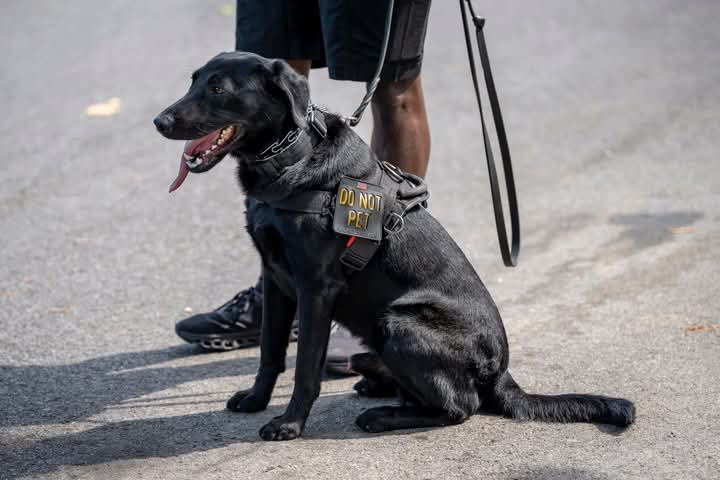The Most Dangerous Dog in the White House: Commander’s Reign of Terror
The White House has hosted many memorable pets throughout American history, but none have created quite the security crisis that Commander Biden did during his tumultuous time as First Dog. This German Shepherd didn’t just make headlines for being cute or charming, he made them for being genuinely dangerous, accumulating a bite record that would make most dogs candidates for immediate euthanasia.
In a building where every security threat is taken seriously and every potential danger is meticulously managed, one four-legged resident managed to terrorize the most elite security force in America for nearly two years. Commander’s story isn’t just about a misbehaving pet, it’s about what happens when political considerations clash with public safety, and how far institutions will bend their protocols when the aggressor happens to belong to the most powerful family in the country.
The Numbers Don’t Lie
The scope of Commander’s aggressive behavior is staggering when laid out in stark numbers. Commander bit Secret Service personnel in at least 24 incidents at the White House and other locations, according to internal USSS documents obtained by CNN. These weren’t minor nips or accidental encounters, they were documented attacks serious enough to require medical attention and official incident reports.
But the true extent of Commander’s reign of terror may be even worse than initially reported. The German shepherd was involved in at least 11 biting incidents at the White House and in Delaware, including a November 2022 incident where an officer was hospitalized after the dog clamped down. One particularly disturbing incident saw Commander run to an agent and bite them twice, once on the left forearm and once on the thumb.
These incidents weren’t isolated or spread out over many years. Commander bit Secret Service agents about 24 times between October 2022 and July 2023, creating a sustained pattern of violence that raised enough concern among Secret Service leaders that they began tracking the incidents systematically. For context, most dogs would face immediate removal from their homes and potential euthanasia after just one serious biting incident involving a stranger.
The Security Nightmare
Imagine being a Secret Service agent, sworn to take a bullet for the President of the United States, only to find yourself more likely to be injured by the President’s own dog than by any external threat. The absurdity of the situation was not lost on the agents who found themselves dodging attacks from a furry family member while trying to protect the First Family.
The incidents created unprecedented security challenges for an agency already dealing with complex threat assessments and protection protocols. Agents had to simultaneously maintain their vigilance for genuine security threats while watching for sudden attacks from a 70-pound German Shepherd who seemed to view them as enemies rather than protectors.
One documented incident that particularly highlighted the problem occurred on October 2, 2022, when an agent was bitten on the forearm while holding the door open in the area between the West Wing and the residence. The incident involved President Joe Biden directly, as Commander and the President were entering the Palm Room through the West Colonnade when the attack occurred. The agent was literally injured while performing a routine courtesy for the President, attacked by the President’s own dog in the process.
The Pattern of Violence
What made Commander particularly dangerous wasn’t just the frequency of his attacks, but their unpredictable nature and the fact that they seemed to escalate over time rather than improve with training or intervention. The dog demonstrated a sustained pattern of aggression that defied typical behavioral modification approaches.
The incidents weren’t limited to one type of interaction or location. Commander bit agents during routine security operations, while they were opening doors, during walks, and in various locations throughout the White House complex and at the Biden family’s Delaware properties. This unpredictability meant that agents could never let their guard down, creating a constant state of tension and hypervigilance beyond what their jobs already required.
Unlike many aggressive dogs who show warning signs before attacking, Commander seemed to strike suddenly and without provocation. Agents described incidents where the dog would appear calm and then suddenly lunge and bite, making it nearly impossible to anticipate and prevent attacks.
The Cover-Up Culture
Perhaps most troubling about Commander’s saga was the apparent reluctance to address the problem decisively, despite the clear danger he posed to federal agents. The White House initially downplayed the severity of the incidents and suggested they were working on “additional leashing protocols” and training solutions, as if the problem was simply one of management rather than fundamental aggression.
The Biden administration seemed determined to handle the situation quietly, possibly hoping that training and management changes could resolve the issue without the negative publicity that would come from removing a beloved family pet. However, this approach put Secret Service agents in the impossible position of continuing to work in an environment where they faced regular attacks from an animal they were not allowed to defend themselves against.
The administration’s handling of the situation raised uncomfortable questions about priorities and accountability. If Commander had been any other dog attacking federal agents, he would have been removed immediately and likely euthanized. The fact that he belonged to the President seemed to create a different standard of tolerance for dangerous behavior.
Historical Context: Not the First Dangerous Presidential Pet
Commander wasn’t the first dangerous dog to roam the White House halls, though he may have been the most systematically violent. Theodore Roosevelt’s Bull Terrier Pete once bit a French ambassador, causing an international incident that required diplomatic damage control. The difference was that Pete’s aggression was a single notable incident, not a sustained campaign of violence against security personnel.
The Bidens also had previous experience with aggressive White House dogs. Major, their first German Shepherd, also behaved aggressively, including biting Secret Service and White House staff. They eventually sent Major to live with friends in Delaware after multiple incidents, essentially setting a precedent for how they would handle dangerous pet behavior. The fact that they then brought Commander into the same environment and allowed a similar pattern to develop suggests a troubling lack of learning from their previous experience.
Both John F. Kennedy and Ronald Reagan had dogs that bit White House staff or even the president himself, but none created the sustained security crisis that Commander represented. The scale and frequency of Commander’s attacks were unprecedented in White House pet history.
The Psychological Impact
The psychological toll on Secret Service agents forced to work in an environment where they faced regular attacks from the First Family’s pet cannot be overstated. These are highly trained professionals who signed up to face human threats in defense of the President, not to serve as chew toys for an out-of-control German Shepherd.
The situation created a uniquely demoralizing work environment where agents had to remain constantly vigilant against attacks from an animal they were powerless to defend themselves against effectively. Fighting back against the President’s dog, even in self-defense, could end an agent’s career, leaving them with no recourse except to endure the attacks and hope for administrative intervention that was slow in coming.
The stress of working in an environment with an unpredictably aggressive animal likely affected job performance in other areas, as agents had to divide their attention between watching for genuine security threats and avoiding dog attacks. This created potential vulnerabilities in the security apparatus protecting the most important political figure in America.
The Medical Reality
The injuries Commander inflicted weren’t minor scratches or superficial nips. Multiple agents required medical attention, with at least one requiring hospitalization after Commander clamped down during an attack. German Shepherds possess powerful jaws capable of exerting up to 238 pounds of pressure per square inch, making their bites serious medical events that can cause significant tissue damage, nerve damage, and infection risks.
The medical costs associated with treating Commander’s victims, both in terms of immediate care and potential long-term complications, represented a significant taxpayer expense. More importantly, these were preventable injuries that occurred because administrative priorities took precedence over agent safety.
Beyond the immediate physical injuries, the psychological trauma of being attacked by an animal while trying to perform professional duties creates lasting stress that can affect job performance and personal well-being. Some agents may have developed lasting anxiety around dogs or specific triggers related to their attacks.
The Institutional Failure
Commander’s saga represents a significant institutional failure at multiple levels. The Secret Service, an agency known for its rigid protocols and zero-tolerance approach to security threats, found itself unable to address a clear and ongoing danger to its personnel because that danger happened to belong to the President’s family.
The White House’s slow response to a clear pattern of violence against federal agents suggests a troubling prioritization of political optics over personnel safety. The administration seemed more concerned with avoiding negative publicity about their family pet than with protecting the agents whose job was to protect them.
This institutional paralysis in the face of a clear threat raises broader questions about the ability of these agencies to make difficult decisions when political considerations complicate straightforward security issues. If they couldn’t decisively handle a dangerous dog, what other security compromises might be tolerated for political reasons?
The Final Removal
Commander was eventually removed from the White House in October 2023, nearly a year after the first documented biting incident and only after the situation had become a public relations nightmare for the administration. The dog’s removal came after months of documented attacks, multiple hospitalizations, and growing media attention that made the situation politically unsustainable.
The timing of Commander’s removal suggests that it was driven more by political pressure than by genuine concern for agent safety. If agent welfare had been the priority, the dog would have been removed after the first serious biting incident, not after nearly two years of sustained attacks.
The administration’s statement about Commander’s removal emphasized their care for those who work at the White House and protect them, but this concern seemed to emerge only after the situation became politically embarrassing rather than when the attacks first began occurring.
The Broader Implications
Commander’s story reveals uncomfortable truths about power, accountability, and institutional priorities in American government. The fact that Secret Service agents were expected to endure nearly two years of attacks from a dangerous animal because removing it would be politically inconvenient demonstrates how even the most basic safety considerations can be subordinated to political calculations.
The incident also highlights the unique challenges of providing security for political figures whose personal lives intersect with high-security environments. Presidential families want to maintain normal family relationships, including with their pets, but these desires must be balanced against the safety of the personnel tasked with protecting them.
The precedent set by Commander’s extended stay despite his dangerous behavior creates concerning questions about what other safety compromises might be tolerated when they involve the personal preferences of powerful political figures.
A Legacy of Violence
Commander’s legacy as the most dangerous dog in White House history is secure, though it’s hardly the kind of legacy any family would want for their pet. His story serves as a cautionary tale about what happens when political considerations override basic safety protocols and when institutions fail to protect their own personnel.
The 24 documented attacks on federal agents represent not just statistics, but real injuries inflicted on real people who were simply trying to do their jobs. Each bite was a preventable incident that occurred because administrative priorities took precedence over human safety.
Commander’s removal from the White House ended a dark chapter in presidential pet history, but the questions his presence raised about institutional priorities and accountability remain unanswered. His story stands as a reminder that in the complex intersection of politics, security, and personal life at the highest levels of government, sometimes the most dangerous threats come from the most unexpected sources.
The most dangerous dog in the White House wasn’t a trained attack animal or a security threat that infiltrated the building, it was simply a family pet whose aggressive behavior was tolerated far beyond what would be acceptable in any other context. Commander’s reign of terror may be over, but the institutional failures that allowed it to continue for nearly two years deserve serious examination and reform to ensure that the safety of those who serve our country is never again sacrificed for political convenience.






